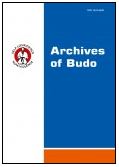2021, Volume 17
A comparison of the body composition and the fat-free fat index of karate trained athletes and other athletes
Agnieszka Chwałczyńska1, Tomasz Rutkowski2, Krzysztof Sobiech3
1Faculty of Physiotherapy, Department of Human Biology , Wroclaw University of Health and Sport Sciences,, Wrocław, Poland
2Jan Długosz University, Częstochowa, Poland
3Faculty of Physiotherapy, Department of Human Biology, Wroclaw University of Health and Sport Sciences,, Wrocław, Poland
Author for correspondence: Agnieszka Chwałczyńska; Faculty of Physiotherapy, Department of Human Biology , Wroclaw University of Health and Sport Sciences,, Wrocław, Poland; email: agnieszka.chwalczynska@awf.wroc.pl
Full text
Abstract
Background and Study Aim: One of the characteristic features of karate training is the partial inability to determine its intensity, which is why it is so important to assess the impact of training on body composition, detailing the fat and lean components. The aim of the study was knowledge about the usefulness of the fat-free index (FFF) as a tool used to estimate the predisposition to practice various sports, with particular emphasis on karate
Materials and Methods: The men (n = 114), aged 15-30, were all competitors in one of the following five sports: kyokushin karate (n = 14), basketball (n = 41), American football (n = 35), soccer (n = 14), swimming (n = 10) and 132 in control group. Body weight and composition were determined using the BC-418MA 8-electrode body composition analyser by Tanita with GMON 3.4.2 software. The electric bioimpedance method was used to determine the percentage of fat mass (FatP), as well as the percentages of mass (FatM), lean mass (FFM), and muscle mass (PMM).
Results: The amateur karate practitioners do not differ in the percentage of body fat from men practicing swimming, basketball or soccer. When assessing the fat-free fat index of the group who practiced karate, it was found that only the American football, as well as the soccer players, had higher values of this indicator when considering it in general and within the torso.
Conclusions: The training form used in kyokushin karate gives similar effects in terms of body composition as swimming training, used in basketball, soccer or American football. At the same time, an important element that should be supplemented in long-term training is the improvement of the symmetry of fat mass distribution.
Key words: martial arts, kumite, kata, muscle mass, training intensity, training load




